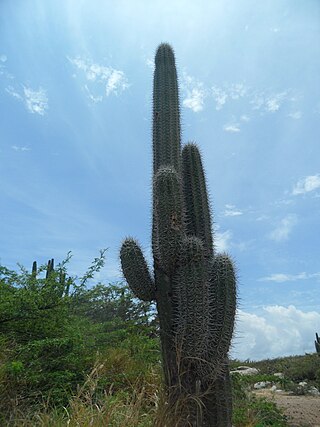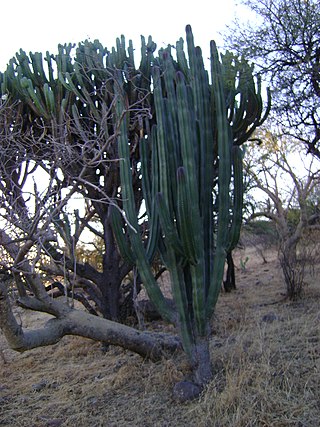
Isolatocereus is a monotypic genus of flowering plant in the family Cactaceae. The only species is Isolatocereus dumortieri that is found in Mexico.

Stenocereus griseus, also known as the Mexican organ pipe, dagger cactus, pitaya, and pitayo de mayo, is a species of cactus.

Stenocereus queretaroensis is a species of cactus from Mexico, including the state of Querétaro. It is cultivated for its fruit.

Stenocereus stellatus is a flowering plant in the family Cactaceae that is found in Oaxaca, Mexico

Stenocereus montanus, known as sahuira, is a species of columnar cactus in the family Cactaceae.

Stenocereus heptagonus is a species of cactus.

Stenocereus martinezii is a species of flowering plant in the family Cactaceae, native to Sinaloa in Mexico. A candelabriform cactus typically 5 to 7 m tall, it is easy to propagate from cuttings, so local people use it to build live fences.

Pachycereus weberi is a columnar cactus plant native to Mexico.

Echinocereus brandegeei is a species of cactus native to Mexico.

Echinocereus stolonifer is a species of cactus native to Mexico.

Echinocereus schereri is a species of cactus native to Mexico.

Stenocereus beneckei is a species of cactus in the genus Stenocereus, endemic to Mexico.
Stenocereus fricii is a species of cactus in the genus Stenocereus, endemic to Mexico.
Stenocereus chacalapensis is a species of cactus in the genus Stenocereus, endemic to Mexico.
Gymnocalycium kieslingii is a species of cactus in the genus Gymnocalycium, endemic to Argentina.
Stenocereus chrysocarpus is a species of cactus in the genus Stenocereus, endemic to Mexico.
Stenocereus humilis is a species of cactus in the genus Stenocereus, endemic to Mexico.

Stenocereus zopilotensis is a species of cactus in the genus Stenocereus, endemic to Mexico.

Stenocereus kerberi is a species of cactus in the genus Stenocereus, endemic to Mexico.

Stenocereus quevedonis is a species of cactus in the genus Stenocereus, endemic to Mexico.
















